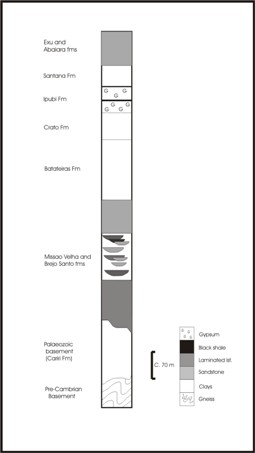
Box 3: Geology of the Araripe Basin
The Araripe Basin is a fault bounded pull-apart basin sandwiched between two megafractures in the Borborema Massif of the Brazilain Pan African basement. The sedimentary fill is largely Late Jurassic to mid or late Cretaceous, but high resolution dating has eluded most attempts to establish precise ages of most of its stratigraphic units. The oldest strata may be Devonian, and were down-faulted in the early stages of the basin's development, apparently related to the opening of the northern part of the South Atlantic Ocean. The earliest workers divided the strata into three main units, a lower arenaceous sequence, now called the Brejo Santo and Missao Velha formations, a middle unit in which limestones form a conspicuous part, and an upper arenaceous unit, now called the Exu Formation. The middle unit yields the spectacularly preserved fossils for which the basin has become famous.
This unit has received more than its fair share of nomenclatural attention, and has variously been called the Calcareo do Sant’ana, the Santana Formation, the Araripe Group and the Santana Group, all differing slightly in definition and scope. Today most geologists recognise a lower Rio Batateiras Formation of largely fluviolacustrine clastics, overlain by the Crato Formation, dominated by fine clastics but containing prominent laminated limestones (e.g., the Nova Olinda Member). The Crato Formation passes up into the Ipubi Formation (laminated and massive evaporates) mainly of gypsum deposits up to 30m thick. A significant hiatus event separates these lower formations from the Santana Formation, with its famous nodule-bearing Romualdo Member.
Several important unconformities and disconformities occur, which may be related to sequence boundaries in Brazil’s coastal Cretaceous basins. Much sedimentation was syntectonic, and drastic switches in sediment type reflect changes from terrestrial, lacustrine, lagoonal and even fully marine conditions. At times salt lakes dominated, now of significant economic importance in the region, for the gypsum they supply.
The final phase of basin fill saw a switch from marine conditions, (echinoids and gastropods) to poorly sorted fluvial sandstones and conglomerates of the Exu Formation. Although dating these deposits has proved difficult, many consider the Crato Formation to be of Late Aptian age, while the nodules of the Santana Formation are frequently cited as Albian (ages as young as Turonian have been suggested).
Although the sequence appears horizontal, part of this is an illusion generated by peneplanation. In fact, the strata are locally quite tectonically disturbed, attesting to late stage movements postdating the mid-late Cretaceous.